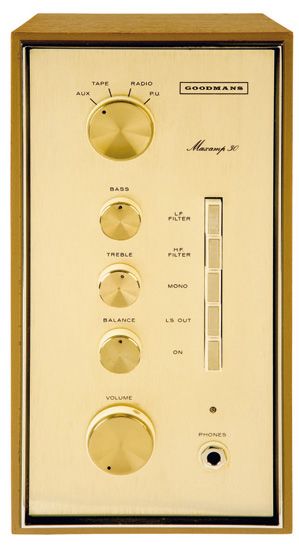Goodmans Maxamp 30 (Vintage)

Goodmans was one of the most prolific loudspeaker makers of the 1960s, also supplying the radio and television trade. The company ran from 1932, ending when the TGI group was broken up in 2004. But the brand name as such survives marketing a range of DVB set-top boxes and LCD TV sets.
Introduced in 1966 with a price tag of £49 10s, this compact little amplifier, the Maxamp 30, measured just 10in tall, 5in wide and 7in deep. It was beautifully made: resplendent in a high quality polished wooden cabinet with shiny anodised fascia, and a vertical row of complementary white knobs complete with metal inserts.
That said, despite the compact and sophisticated electronics there is something more ‘1950s radio set’ than ‘1960s cutting edge’ to the design. Yet the ergonomics had been very well thought out, the dominant features being the volume control and selector switches, with bass, treble, and balance between them; then we had high and low filter switches, a mono button, loudspeaker and power switches just to one side, plus a neat neon power indicator. A nice touch was its 1⁄4in headphone socket jack, missing from all similar British competitors’ products at that time.
The Maxamp 30 can lay claim to be the first-ever British built amplifier to use RCA’s new silicon transistors in its output stages. The temperature compensated, transformer-less output stage is biased in Class B. The spec claimed 15W RMS per channel into 8ohm loudspeakers, and 10W in to 4 or 15ohm loads. It had a high quality MM pick-up input (3.5mV sensitivity), along with facilities for ceramic and crystal pick-ups. Line inputs were: radio (100mV); auxiliary (3mV); and straight tape inputs (150mV). Tone controls were based on the Baxendall circuit.
From today’s perspectives the circuit is quite basic, and overall negative feedback not quite as high as with some similar vintage designs. A switched AC outlet was provided for turntable or tuner. The case was quite a bit wider than the actual chassis, thus allowing adequate ventilation for the output transistors on either side. This passive ventilation would indicate the amplifier was always intended to be vertical. Internal assembly was on three main PCBs. For servicing the chassis popped out of the cabinet on releasing two screws, with the two side-mounted output ‘panels’ then swinging open from the U-shaped chassis.
BACK WITH A PUNCH
Our Maxamp sample had a few quirks – the bass control was quite out of kilter, and at low levels the volume control mistracked. Radio, Tape and Aux input all needed attenuation. Bass and treble controls worked to good effect, both high and low filters being quite subtle.
Our first record played, a 1965 Decca ‘Phase Four’ stereo LP, suggested this little champ had come back with a punch! But dropping a 12in 45 of Kraftwerk’s ‘Tour de France’ began to reveal some of the obvious limitations. The punchy bass on this track had become somewhat truncated. Trying CD via the attenuated lead was again quite pleasant but checked. Not flat, but hardly forward. Soundstages were trapped within quite a narrow band. Dinah’s ‘Mad About The Boy’ was really disappointing and a favourite Abba track, ‘The Day Before You Came’ too. All had lost an emotional spark somewhere. The amp had quite a personality which it imposed on the overall sound. With ‘swinging’ rock, pop and jazz, it worked, but on more subtle works it became somewhat lost. There was a mild background noise too.
VERDICT
The Goodmans Maxamp 30 delivered a polite, smooth sound, but failed to excite or interest, lacking those tiny low-level details that make high fidelity such fun.
Originally published in the Yearbook 2011


























































